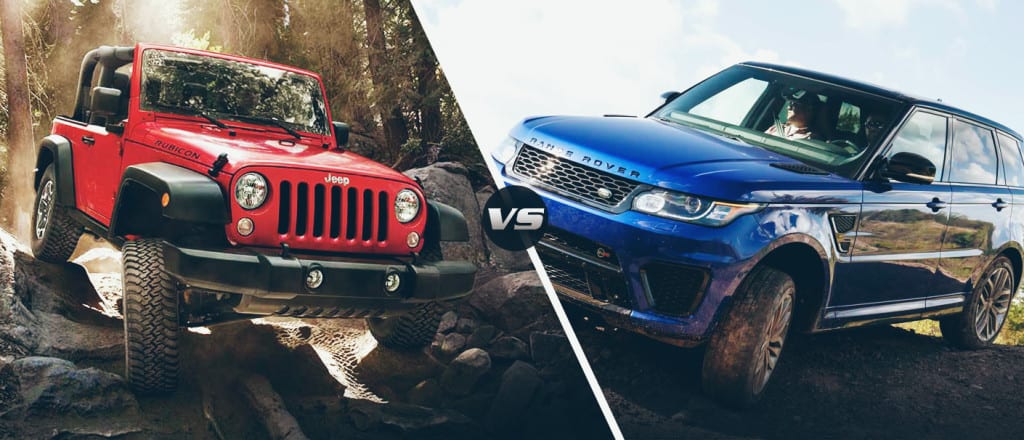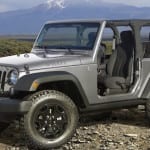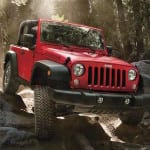The vehicles may have changed, but off-roading hasn’t. There are still the same types of uneven terrain that need to be conquered, the same sense of peril, and the same yearning for exploration instilled in our adventurous hearts. Off-roading used to be a Jeep thing, and you would either find lease a 2016 Jeep Wrangler or buy one to satiate that appetite for adventure. But times have changed, and the off-roading market is almost just as competitive as the soccer-mom van one. This is because these vehicles have adapted over the years to better suit their needs not only off the road, but on it as well.
Being marketed as both a daily driver and an off-roader is a tough line to straddle, so how is the 2016 Wrangler Rubicon fairing in a market like this? It’s still the long-time lover of old school off-road enthusiasts, but is it pairing up okay against more modern off-roaders like the Land Rover?
Design
Jeep found a niche when it came to the type of design needed for off and on-road use, and they have stuck to that basic idea over the years. The 2016 Wrangler Rubicon is sporting an upgraded heavy duty Dana 44 front axle, and a shorter 4.10 gear-ratio in the rear axle for improved performance on and off the road. Turning on those axles are standard 17-inch alloy wheels with 32 inch on/off-road tires. There is also a transfer case skid plate, protecting an upgraded transfer case that provides a lower crawl ratio. It comes with the standard and well-loved electronic front and rear locking differentials, and the electronic sway bar disconnect.
Range Rover
The 2016 Range Rover Sport has seen some upgrades in terms of design as well. Primarily, its lost some weight. It’s been remade with an all-aluminum structure that caused an 800 pound weight loss and increased fuel efficiency. The Range rover is sitting on 19-inch five split-spoke style wheels that are supported by a slew of features to help keep them on the ground. It’s sporting electronic cross linked air suspension with automatic load leveling, reactive grounding response, terrain response, and roll stability control. The Wrangler seems to be lacking some of these, but it also seems like these are catered for lighter off-roading use, rather than getting down and dirty in the mud.

While this vehicle seems to be sporting some more technological advancements in the off-roading department, that’s really all its sporting. The design of the Rover is still clunky, and in rough terrain it’s very unforgiving, something the Rubicons suspension system and axles make sure of. They both have about the same type of wading depth and obstacle clearance from the ground to the bottom of the vehicle, but the Wrangler can get through the mud better thanks to its lower gear ratio.
Dimensions
The Rubicon is 164.3 inches long, 73.7 inches wide, and 70.9 inches high (varies with soft or hard top). It has a 95.4 inch wheelbase with a base curb weight of about 4,129 pounds (again, varies depending on transmission selection). The Rover has an overall length of 191.2 inches, 87.4 inches wide, and 70.1 inches high. It sits on a 115.1 inch wheelbase and has gone down in curb weight since its last model.
Even though the Rover has a longer wheelbase, the overall length and width are much bigger than the Wranglers. This is also, in part, too why this vehicle could be so clunky in rough terrain. It may ride smooth on the road, but off the road a smaller frame is much easier to handle. 191.2 inches is a lot of car to try and pull up a mountain, and the Rubicon will be able to get through tighter spaces for sure.
Engine
The 2016 Wranglers all come with the same type of engine, a 3.6-liter V6 24-Valve VVT engine putting out 285 horsepower and 260 pound-feet of torque. On the Rubicon, the four wheel drive is standard an includes high to low range gearing with the upgraded transfer case that was discussed earlier. The Rubicon is able to reach 0-60 in about 8.8 seconds, which is decent for a vehicle of that weight.
The Range Rover Sport comes with two engine options, a LR 3.0 Liter Td6 Turbocharged diesel that puts out 254 horsepower and 443 pound-feet of torque. It also comes with a LR-V6 Supercharged 3.0-liter engine that nets 340 horsepower and 332 pound-feet of torque. It is able to accelerate from 0-60 in 7.1 seconds with the diesel, and 6.9 seconds with the V6.
It looks like the Rover is able to beat the Rubicon in a 0-60 mph test, but how about climbing? It looks like the diesel engine can haul the oversized Rover through rough terrain pretty well because of its big torque output, but that doesn’t mean the Rubicon is worse than it. In fact, thanks to that upgraded transfer case and lower gear ratio (and a much smaller frame), I bet the Rubicon is still able to climb quicker and better than the Rover.
The engine in the Rubicon gets 17 city and 21 highway, whereas the Rover is able to get the same amount of mpg in the city but 2 more mpg when it comes to highway travel. But remember, the only reason the Rover has a similar fuel economy to the Rubicon is because of the aluminum that was put in to help offset its massive size.
Transmission
The Rubicon comes with a six-speed manual transmission, and the Rover gets a 8-speed automatic with CommandShift. CommandShift is a way for the Rover to downshift only to second gear while on normal road conditions, and when off-roading you can disable it to shift down to first gear. Basically, it’s a way to control the amount of fuel you spend and power your engine outputs depending on the environment you are in.
The Rubicon, however, comes standard with that good old six-speed manual. There is a reason for that, manuals give you far more control over the up/downshifting, and you don’t need to worry about enabling or disabling a system. Many consumers agreed that after a while agreed CommandShift became pointless, saying the Rover did okay in most conditions with it disabled. In the end, leaving you with an automatic transmission that might do okay in off-roading conditions, but it still lacks the control needed to really climb rough terrain.
Pricing
There are far more Rubicons out there than there are Range Rovers, in part probably because of the price. The Rubicon is one of the top of the line off-roading vehicles offered by Jeep, and it starts at a base MSRP of $33,095. Where the Ranger Rovers base model starts at an MSRP of a ridiculous $64,950. You are paying for comfort as well as performance when it comes to the Rover.
The Rover is far more luxurious, where as the Rubicon is simply there to do the job. Whereas the Rover seems to be catered more towards casual drivers. For example, the CommandShift is the Rovers way of trying to balance the control of a manual and the convenience of an automatic to draw a bigger crowd. Rather than the Rubicon, that comes standard with the six-speed. The Rubicon does have an automatic available, but the six-speed manual comes standard for a reason.
The Rubicon has stayed true to its roots, and gave drivers that continued promise of familiarity and dependability on and off the road. Which could also be a factor as to why we still see more Wranglers on the road than Land Rovers, and also why it’s still doing just fine in this strange off-roading market.


